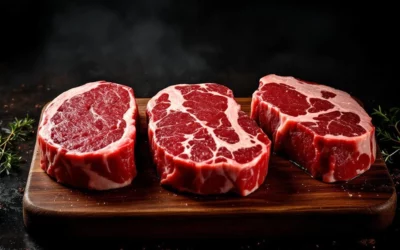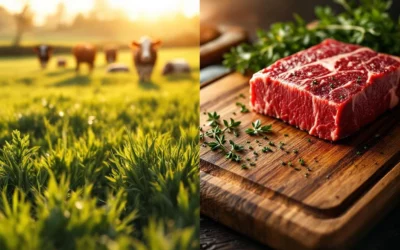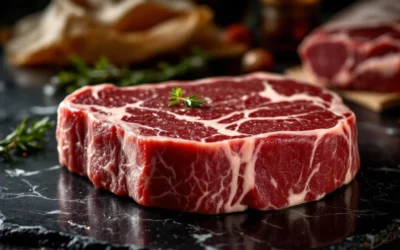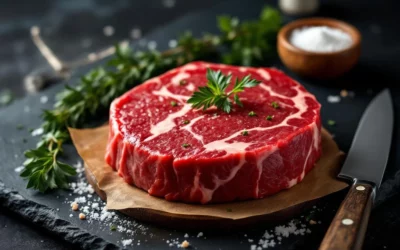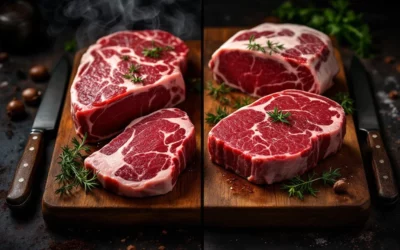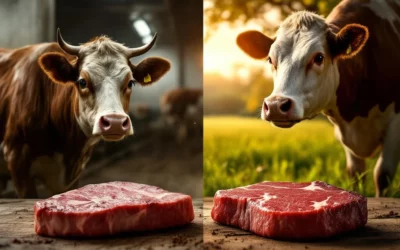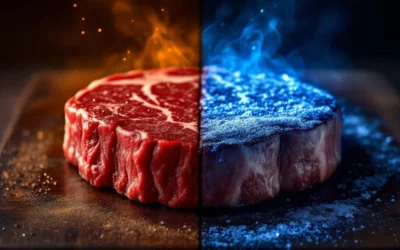Prime, choice, and select are the three main grades of the American USDA grading system for beef. Prime beef has the most marbling (fat streaks) and comes from young cattle, while choice offers a good balance between quality and price with moderate marbling. Select is the leanest meat with minimal marbling, making it drier but also healthier. The difference lies primarily in the amount of intramuscular fat, which directly affects the flavor, juiciness, and tenderness of the meat. The USDA beef grading system has existed since 1927 and was developed to help consumers choose meat with consistent quality. This American system […]
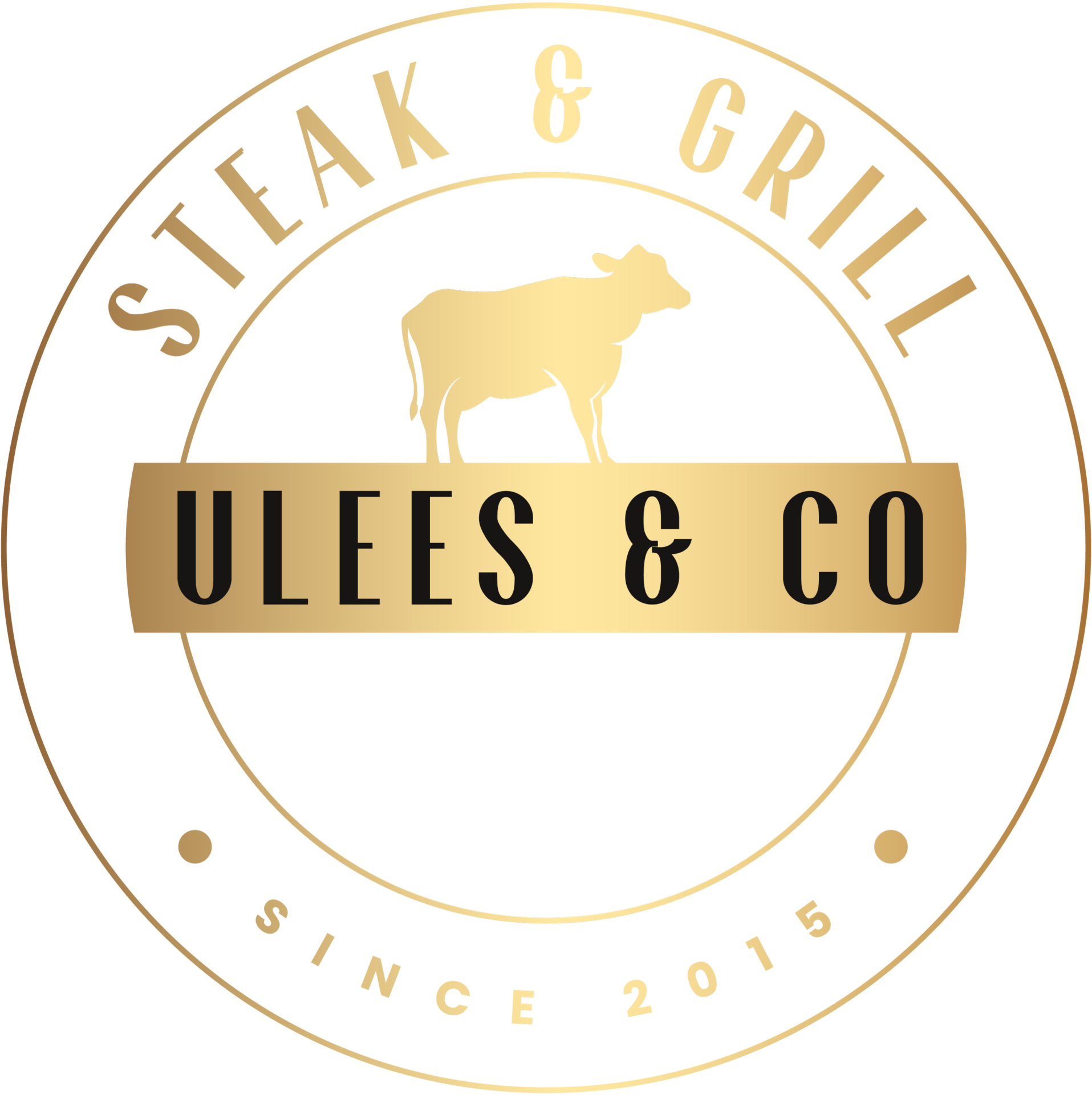
Premium Meat
Laatste blogposts
Which types of meat are produced most sustainably?
The most sustainably produced types of meat are grass-fed beef, organic pork, wild game from nature conservation, and lamb from sheep farmers who graze natural areas. These meat types have a lower environmental impact due to natural feeding, better living conditions, reduced antibiotic use, and often shorter transport distances. With sustainable meat, it is primarily about the way animals are kept, what they eat, and how production impacts nature and the environment. Sustainable meat is produced with attention to animal welfare, environment, and natural processes. The key factors that determine whether meat is sustainable are the animal’s diet, living conditions, transport distance, water usage, CO2 emissions, and the use of antibiotics. At […]
How do you recognize quality meat by its packaging?
Recognizing quality meat from packaging begins with examining the color, checking the label, and inspecting the packaging itself. Look for a natural, bright color that matches the type of meat, search for quality marks and origin information on the label, and check that the packaging is properly sealed without bulging spots or leaks. These visual cues help you make the best choice directly in the store for fresh and flavorful meat. The color of meat tells you a lot about freshness, but not always what you think. Fresh beef has a bright red color due to […]
What does hormone-free mean in beef?
Hormone-free beef means that the meat comes from cattle that have not received synthetic growth hormones during their lifetime. In Europe, the use of growth hormones in livestock has been banned since 1988, but in countries such as the United States and Canada, this practice is still permitted. With hormone-free meat, the animals grow naturally, which results in a longer raising period but often also in better meat quality with more natural flavor. Hormone-free beef comes from cattle that have been raised without synthetic growth hormones. This means that the animals have only their own naturally produced hormones, without the addition of artificial growth promoters. […]
Which Dutch meat cuts are comparable to international cuts?
Dutch meat names often differ from international terminology, making it challenging to find your favorite steak at the local butcher. While you would order a ribeye or T-bone at an international steakhouse, you would ask a Dutch butcher for an entrecote or côte de boeuf. These differences stem from centuries-old traditions in the butchering trade, where each country has developed its own methods of cutting and naming. Fortunately, excellent Dutch alternatives are available for every international cut. The difference between Dutch and international meat names lies primarily in how the beef is cut and the historical development of […]
How does stress in animals affect meat quality?
Stress in animals has a direct impact on meat quality through the production of stress hormones such as cortisol and adrenaline. These hormones cause chemical changes in muscle tissue, resulting in tougher, drier meat with abnormal color and taste. Meat from stressed animals often has a higher pH value, causing it to spoil faster and be less tender. This is why premium restaurants choose meat from animals that have been treated with care. When an animal experiences stress, the body shifts into survival mode. The adrenal medulla immediately produces adrenaline, while the adrenal cortex produces cortisol. These stress hormones trigger a chain reaction that […]
What is the difference in taste between fresh and frozen steak?
The difference between fresh and frozen steak lies primarily in texture and moisture loss during the freezing and thawing process. Fresh steak retains its natural juices and structure, while frozen steak may undergo subtle textural changes due to ice crystal formation. With professionally frozen, high-quality meat, the flavor difference is often minimal, but the preparation method and thawing technique play a crucial role in the final result. The most important difference between fresh and frozen steak lies in the cellular structure of the meat. In fresh steak, the cells remain intact, preserving all natural juices. During freezing, ice crystals form in the meat […]
How do you reserve a table at popular steakhouses in Amsterdam?
For reserving a table at popular steakhouses in Amsterdam, it’s best to use online reservation systems like TheFork or the restaurant’s own website, ideally 2-3 weeks in advance for weekends. Phone reservations work well for special requests, while weekday evenings and early time slots (5:30-6:30 PM) usually offer more availability. When making your reservation, ensure you provide all important information: number of guests, dietary preferences, allergies, and any special occasions. Amsterdam has developed over recent years into a true steakhouse capital with countless premium restaurants specializing in perfectly prepared steaks. This popularity means that without a reservation you’ll often face a closed […]

Arnhem
Vlees & Co Arnhem
Nieuwe Plein 22a
6811 KR Arnhem
026 70 24 010
arnhem@vleesenco.nl
Nijmegen
Vlees & Co Nijmegen
Kelfkensbos 32
6511 TB Nijmegen
024 20 68 973
nijmegen@vleesenco.nl
Amsterdam
Vlees & Co Amsterdam
Albert Molhof 1
1031 JK Amsterdam
020 786 89 22
amsterdam@vleesenco.nl
